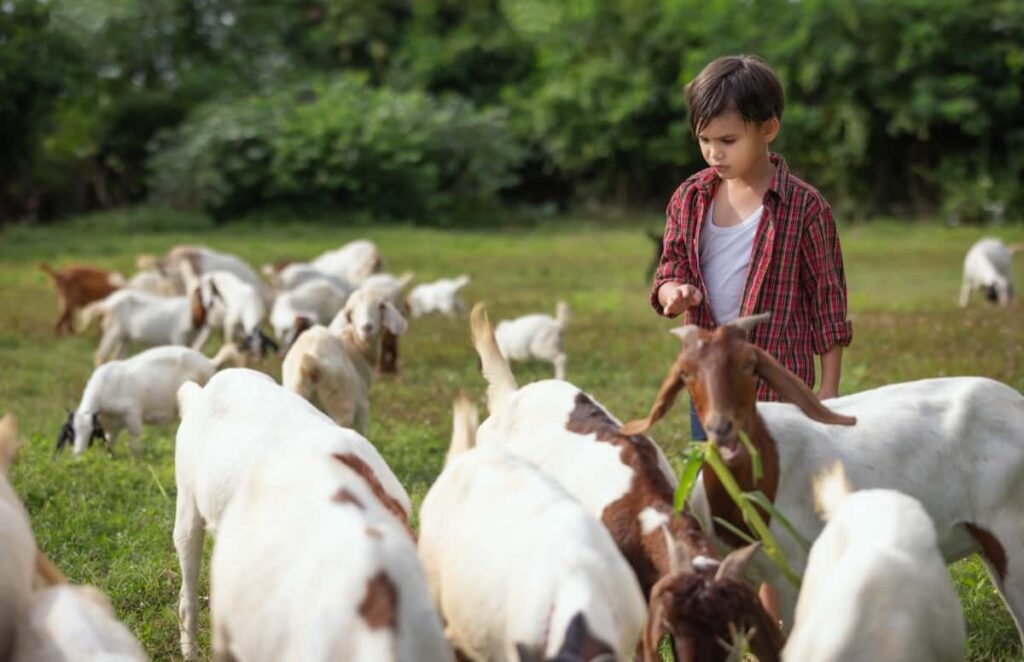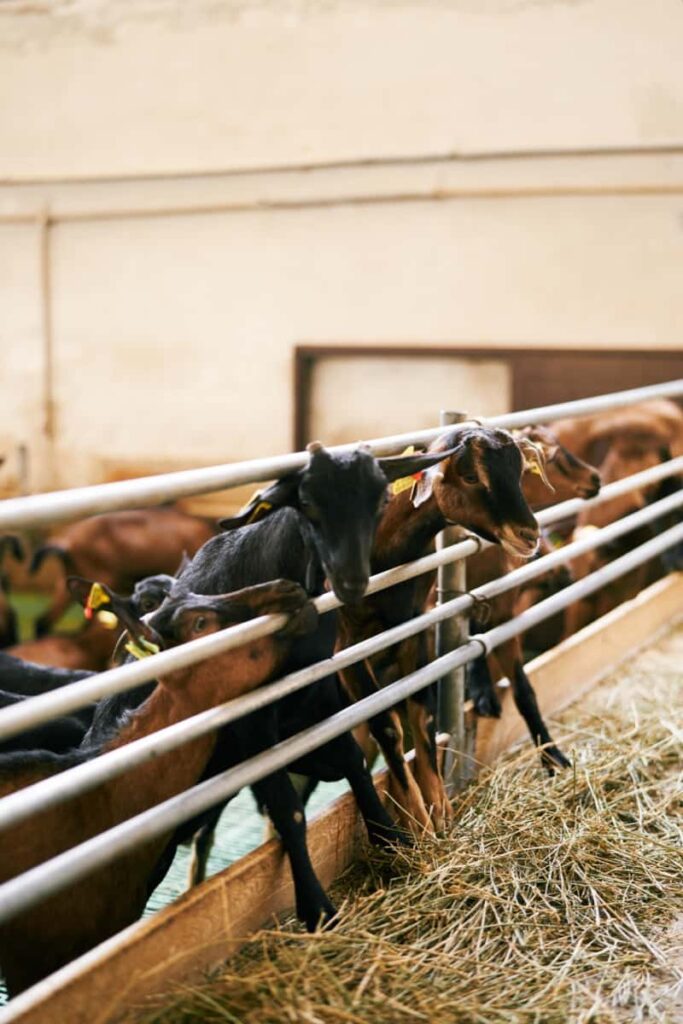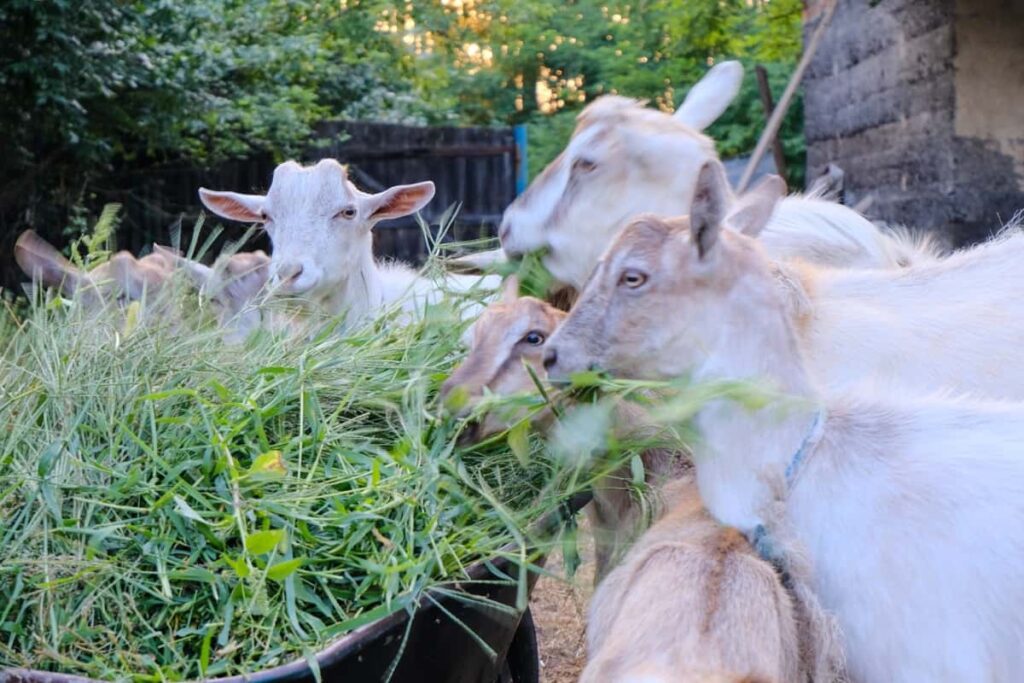Goat farming is an excellent way to build a sustainable income while enjoying the benefits of raising these friendly and intelligent animals. Goats can be raised for their milk, meat, and wool. Goats are small ruminants requiring minimal living space, making them ideal for small-scale farms or homesteads.

Housing and Shelter for Goat Farming in Nepal
- It is important to provide adequate shelter to protect them from weather conditions such as extreme heat, cold, rain, or snow.
- Different housing structures are available depending on the size of your herd and budget. Some common types include open-air enclosures, barns, or sheds that offer more protection during unfavorable weather conditions.
- Proper ventilation is another key factor in ensuring good health for your goats.
- In addition to proper sheltering facilities, providing enough space for each goat is essential for their well-being.
Is Goat Farming Profitable in Nepal?
- Goat farming has become profitable in Nepal due to the increasing demand for goat meat and milk. The country’s geographical terrain is suitable for raising goats, making it an ideal place for commercial goat farming.
- One of the reasons why goat farming is profitable in Nepal is that goats are easier to maintain than other livestock animals like cows and buffaloes. They require less space, feed, and water than these animals, making them more cost-effective.
Feed and Nutrition for Goat Farming in Nepal
- Proper nutrition and feeding are important for the growth and health of goats. As a goat farmer, it is crucial to understand their dietary requirements to ensure they stay healthy and productive.
- The primary food source for goats is hay or pasture grass, but they also need access to clean water at all times. They must vary their diet with other feed options like grains, protein-rich legumes, and mineral supplements.
- Feeding your goats too much grain can lead to digestive problems such as bloat or acidosis. Therefore, it’s best to introduce new feeds gradually over time. Make sure that you provide fresh water every day in clean containers.
- Pay attention to your goat’s body condition score (BCS). A BCS helps determine if a goat needs more or less feed. Overfeeding leads not only to waste of money on excess production but also obesity which may cause serious health issues.
Goat Breeding Management
- Goat breeding is a crucial aspect of goat farming. Proper breeding ensures that the goats are healthy, have good genetic traits, and can produce high-quality milk or meat.
- One important step in goat breeding is selecting the right breed for your farm. It would help to select a goat breed that suits your climate and environment and meets your specific needs.
- Another key factor to consider in goat breeding is genetics. It’s important to select healthy goats with strong genetic backgrounds because this will help ensure that future generations of goats will be just as healthy and productive.
Steps to Start a Goat Farm in Nepal
- Decide on the type of goats you want to raise based on their purposes, such as meat or milk production. Then, research local regulations regarding livestock ownership and acquire any necessary permits or licenses.
- Next, choose a suitable location for your goat farm with ample space for grazing and secure fencing. Build appropriate shelters for your goats to protect them from harsh weather conditions.
- Invest in quality feed and ensure proper animal nutrition by consulting a veterinarian or animal nutritionist. Develop a feeding timing that meets the specific needs of your goats.
- Developing a breeding plan considering genetics, health, and market demand is also important. Consider working with other breeders or farmers to diversify bloodlines and improve herd health.
- Marketing strategies should be developed early on to sell products effectively. Establish relationships with potential buyers at farmer’s markets or grocery stores before launching full-scale production.
In case you missed it: Goat Breeding and Genetics for Improved Productivity and Disease Resistance

What is the Best Breed of Goats in Nepal?
- Nepal is known for its diverse goat breeds, which suit its terrain and climate well. Four indigenous goat breeds, namely Terai, Khari, Sinhal, and Chyangra, are found in Nepal. These goats have evolved to adapt to the local environment.
- In addition to these indigenous breeds, exotic goat breeds such as Jamunapari, Barbari, Beetal, and crossbreeds can also be found in Nepal.
Requirements to Start Goat Farming in Nepal
- It would help to have adequate land for your goats to graze and move around freely. The land size will depend on the number of goats you plan to keep.
- It would help if you had proper shelter facilities for your goats. This includes barns or sheds that provide enough space for feeding, milking, and resting areas. Ensuring proper ventilation and temperature regulation within the shelter is also important.
- Goat farming requires good quality feed and nutrition management practices. Your goats should always have access to fresh water and a balanced diet of hay, grains, and minerals.
- Regularly monitoring the goats’ health and growth must be carried out to identify potential issues like diseases or infections that could affect their productivity.
Which Is the Best Place for Goat Farming in Nepal?
Among many places, the Gorkha district stands out as one of the best places for goat farming. The district has over 200 thousand goats and nearly 250 commercial goat farms. This makes it a good place for beginners who want to learn about raising goats on a larger scale. Moreover, Gorkha offers a variety of breeds suitable for different purposes, such as meat production or milk production.
Jamunapari crossed, Khari crossed, and Barbari crossed breeds are popular among farmers in this area due to their high productivity rates. Another advantage of farming goats in Gorkha is the availability of resources like land and water, which are essential for sustainable livestock management practices.
Goat Farming Challenges in Nepal
- One of the main challenges faced by goat farmers is finding quality feed and ensuring proper nutrition for their goats. In addition, disease control can also be a major issue that requires careful monitoring and management.
- Another challenge goat farmers face in Nepal is the lack of access to markets where they can sell their products at fair prices. This often leads to low-profit margins and difficulties in sustaining the business.
- Despite these challenges, with the right knowledge, skills, and resources, goat farming has great potential to provide sustainable income for Nepalese farmers while contributing to food security in the country.
In case you missed it: Best Practices for Disease Prevention and Management in Goats: Strategies for Maintaining a Healthy Herd

Conclusion
Goat farming is animal husbandry where goats are raised for their milk, meat, and other by-products. Goat farming is a profitable and rewarding venture for beginners and experienced farmers.
- Goat Milking Practices and Equipment: A Beginner’s Guide
- Goat Farming for Fiber: Producing Mohair and Cashmere
- Maximizing Goat Milk Production: Tips for Dairy Goat Farmers
- Goat Farming as a Family Business: Strategies for Success
- Profitable Kenya Goat Breeds for Commercial Dairy and Meat Business
- Unlock the Secrets of Oberhasli Goat: Discover Raising and Management Practices
- Ultimate Guide to Myotonic Goats: Explore Profile to Raising
- Unlock the Secrets of Rove Goat: Discover Management Practices
- Ultimate Guide to Malwa Goat: Explore from Origin to Management Practices
I want to start goat firming please provide me the information regarding the species and land required for the farming.
Please guide me, I want to start goat farm.
Please support
Sir, Anil, kindly needed your support, where I bring new goat ? Need your support please
Hello sir,
I want to start goat farm , can you provide me information
I am a beginner. I want to start a goat farm. plz. suggest the following:
1. what is the cost estimate for a new goat farm
which goat breed to choose and where to purchase from?
where to get skilled manpower for shed building
where to apply for government funds and loan
where to contact for training
where to contact for a franchise of a goat breed
I want to start a goat farming in my village
Please guide me in details